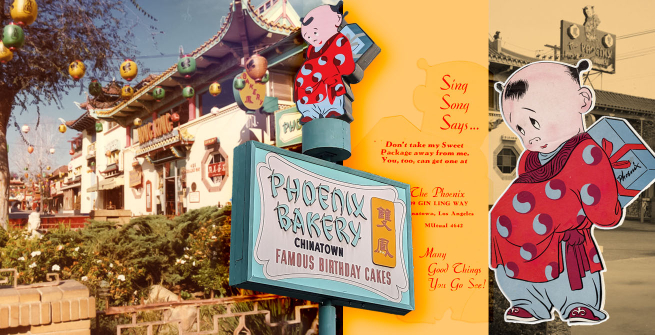Long-time visitors of Chinatown will be very familiar with the storefront with Sing Song, a Tyrus Wong (1910-2016) drawn logo of a bashful little boy in a traditional Chinese haircut with a robe holding a box behind his back with the tagline "sweets for the sweets." Phoenix Bakery, the shop with this famous sign, is a legacy business in Chinatown, first established in 1938 by Fung Chow Chan (1909-2001) and his wife, Wai Hing Chan, née Leong (1918-1994), the year that new Chinatown was built, after the residents of old Chinatown were pushed out.

In the beginning, the family baked more traditional Chinese pastries, such as sugar butterfly cookies, moon cakes, almond cookies, and lotus cakes. They moved in the early 1940s to the Central Plaza in a small 15 x 50 feet location on 409 Gin Ling Way, pictured in the corner below.
After World War II, Chow's younger brother, F. Lun Chan (1921 - 2015) joined the family business and studied to be a baker. He created a strawberry whipped cream cake that has been a stalwart contribution to many family events for decades. This strawberry whipped cream cake is a type of fruit cream cake that is considered a delicacy, and versions of this cake can be found in most Asian bakeries, with versions of this cake made by Chinese, Vietnamese, Filipino, Japanese, Korean, etc. bakeries within the United States and in Asian bakeries throughout the world. It is interesting to ponder why the Phoenix Bakery's two-layer strawberry, cream, almond, and sponge masterpiece did not exist prior to the 1940s.
The sponge cake used in these fruit cream cakes is reminiscent of a chiffon cake, and the reason the cake might be so popular in Asia may be that the chiffon cake recipe is easier to bake in heat and humidity because it does not involve creaming in cold butter into the recipe.
The chiffon cake recipe was invented by Harry Baker (1883–1974) in 1927 and was a long-held secret. The recipe for the cake was unknown until Baker sold his recipe for the chiffon cake in 1947 to Betty Crocker, a brand and fictional character owned by General Mills. Before that time, Harry Baker, who invented the cake in 1927, kept his secret ingredient in the chiffon cake very close to the chest. Stories were recounted, and he was very discreet in how he disposed of the cooking oil bottles he used instead of the butter or shortening traditionally found in cakes. The chiffon cake was the first dessert served at the Brown Derby Restaurant and a version of the original is now served at the replica of the Hollywood Brown Derby at Disney World.


Below is the recipe in a Central Library copy of the chiffon cake recipe in the first hardcover Betty Crocker cookbook of 1950.
Chiffon cake is most likely named after the chiffon pie, invented in 1926 by Monroe Boston Strause (1901-1981), an open-faced pie with an airy filling, which is made similar to the process for a chiffon cake by folding meringue (stiffly-beaten egg whites) into the batter. The chiffon cake is comparable to and yet different from an angel food cake. The first recipe for this cake was published in 1839 in The Kentucky Housewife; an angel food cake has no added fat, whereas the chiffon adds in cooking oil.
What else happened to Phoenix Bakery? In 1962, Lun's older brother, Chow, motivated by not being able to get a bank loan despite having a successful bakery, opened Cathay Bank, the first Chinese-American-owned bank, and then East West Bank, the first federally chartered Chinese-American savings institution, in 1973. In 1977, they opened a second location that we now know on 969 North Broadway. In 1985, the family also expanded into restaurants named Phoenix Express, featuring bakery products and Chinese fast food.


However, these food establishments were unsuccessful, and only the location on 969 North Broadway remains.


